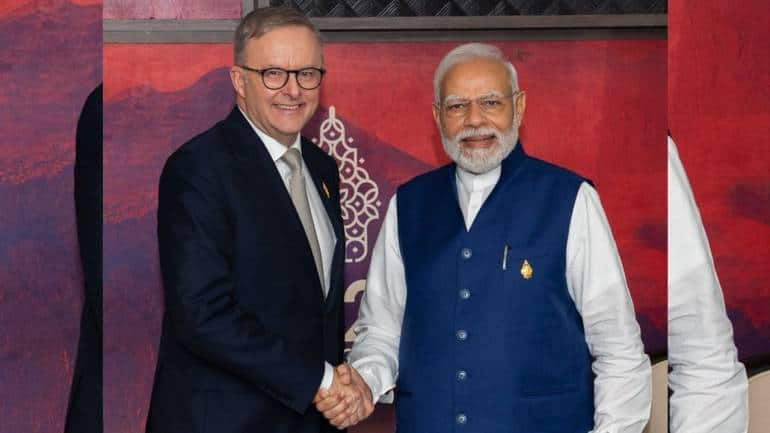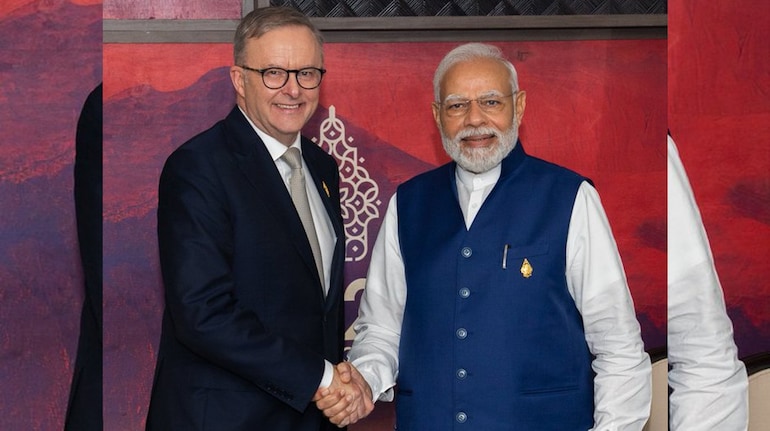


Australian PM Anthony Albanese with Indian PM Narendra Modi at the G20 Summit in Bali (Image Source: Anthony Albanese via Twitter /@AlboMP)
The Australian parliament on November 22 approved a free trade agreement with India, Prime Minister Anthony Albanese confirmed on Twitter.
BREAKING: Our Free Trade Agreement with India has passed through parliament. (with @narendramodi at the G20) pic.twitter.com/e8iG3gpTgr
— Anthony Albanese (@AlboMP) November 22, 2022
= 768 && (adKey.indexOf(“Moneycontrol”) != -1) && (adKey.indexOf(“Moneycontrol_Mobile_WAP”) = 768 && (adKey.indexOf(“MC_ENG_DESKTOP”) != -1 ) && (adKey.indexOf(“MC_ENG_PWA”) < 0) ){ setTimeout(function() {googletag.cmd.push(function() { googletag.display("MC_ENG_PWA/MC_ENG_PWA_NEWS/MC_ENG_PWA_ECONOMY_AS/MC_ENG_PWA_ROS_NWS_ECO_AS_ATF_300") });}, 2000); }if (width
Albanese and Indian PM Narendra Modi had discussed the deal on the sidelines of the 17th G20 Summit in Bali, Indonesia last week. The Australian PM is also set to visit India in March.
What is the deal?
The Australia-India Economic Cooperation and Trade Agreement (ECTA) was signed in April but the Indian parliament is yet to pass the deal.
“Closer economic ties with India are a critical component of the government’s trade diversification strategy,” AP quoted Australian Trade Minister Don Farrell as saying.
“The quality of this agreement, in terms of market access and opportunity for Australian businesses, demonstrates India’s commitment to our bilateral economic partnership. India presents unparalleled growth opportunities for Australian business across a range of sectors, from food and agriculture, technology and green energy, to health and education services,” Farrell added.
Under the deal, taxes on 90 percent of Australian goods exported to India including meat, wool, cotton, seafood, nuts and avocados will be removed.
= 768 && (adKey.indexOf(“Moneycontrol”) != -1) && (adKey.indexOf(“Moneycontrol_Mobile_WAP”) = 768 && (adKey.indexOf(“MC_ENG_DESKTOP”) != -1 ) && (adKey.indexOf(“MC_ENG_PWA”) < 0) ){ setTimeout(function() {googletag.cmd.push(function() { googletag.display("MC_ENG_PWA/MC_ENG_PWA_NEWS/MC_ENG_PWA_ECONOMY_AS/MC_ENG_PWA_ROS_NWS_ECO_AS_BTF_300") });}, 2000); }if (width
For India, this is the first trade agreement with a developed country after more than a decade.
As per an official government statement, the agreement “encompasses cooperation across the entire gamut of bilateral economic and commercial relations between the two friendly countries, and covers areas like trade in goods, rules of origin, trade in services, technical barriers to trade, sanitary and phytosanitary measures, dispute settlement, movement of natural persons, telecom, customs procedures, pharmaceutical products, and cooperation in other areas”. Eight subject-specific side letters covering various aspects of economic cooperation were also concluded as part of the agreement.
What the deal covers?
— It covers almost all tariff lines and India will benefit from preferential market access provided by Australia on 100 percent of its tariff lines.
— It includes all labour-intensive sectors of export interest to India such as gems and jewellery, textiles, leather, footwear, furniture, food, and agricultural products, engineering products, medical devices, and automobiles.
On the other hand, India will be offering preferential access to Australia on over 70 percent of its tariff lines, including lines of export interest to Australia which are primarily raw materials and intermediaries such as coal, mineral ores, and wines.
— For trade in services, Australia has offered wide ranging commitments in around 135 sub sectors and Most Favoured Nation (MFN) status in 120 sub sectors which cover key areas of India’s interests like IT, IT enabled services, business services, health, education, and audio visual.
Some of the key offers from Australia in the services space include quota for chefs and yoga teachers; post study work visa of 2-4 years for Indian students on reciprocal basis; mutual recognition of professional services and other licensed/regulated occupations; and work and holiday visa arrangement for young professionals.
On the other hand, India has offered market access to Australia in 103 sub sectors and Most Favoured Nation status in 31 sub sectors from 11 broad service sectors such as business services, communication services, and construction and related engineering services.
Both sides have also agreed to a separate annex on pharmaceutical products which will enable fast-track approval for patented, generic, and bio similar medicines.
Trade partnership scope
India is Australia’s ninth largest trading partner, while Australia is the 17th largest trading partner. Bilateral trade for both merchandise and services between the countries was valued at $27.5 billion in 2021.
India’s merchandise exports to Australia grew 135 percent between 2019 and 2021, with imports from Australia at $15.1 billion in 2021 (largely of raw materials, minerals, and intermediate goods). Further, broad-based and finished products exports were $6.9 billion in 2021.
Australia-Britain deal also greenlit
Australia also okayed a similar deal with Britain which had left the European Union. Britain is also yet to okay the agreement on their end.
(Inputs from AP, ANI and the PIB)

